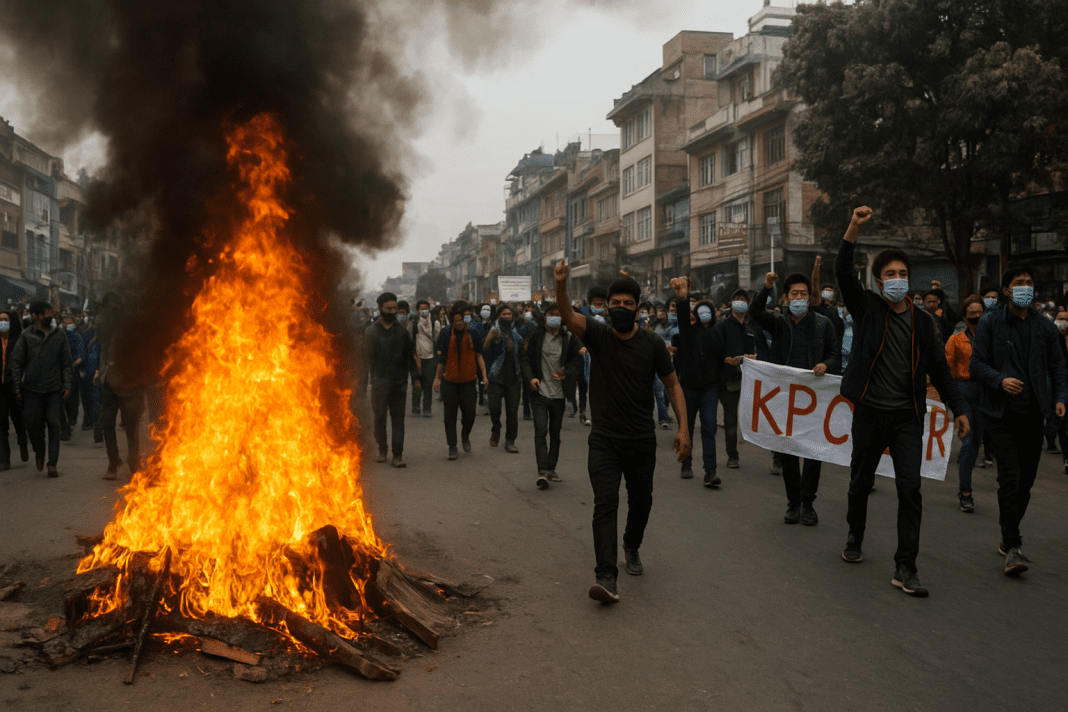Nepal is currently facing an explosive situation as large numbers of young people, mostly from Generation Z, have taken to the streets demanding justice, accountability, and an end to corruption. The protests, which began after the government blocked major social media platforms, have continued for a second day even after the restrictions were lifted.
Widespread Protests Shake Nepal
Students and young professionals are leading the demonstrations. They are expressing their anger over corruption in the government, lack of job opportunities, and restrictions that affect their freedom to communicate and express themselves. Protesters gathered in areas such as Kathmandu, Lalitpur, and other cities, burning tyres, shouting slogans, and clashing with police forces.
In many parts of Kathmandu, protesters stormed homes of political leaders and even set fire to private residences, including that of the Communication Minister. Protesters blocked roads and authorities imposed curfews in several districts to try and control the unrest. Police used water cannons, tear gas, and in some cases live ammunition to disperse the crowds.
Azerbaijan Charges India With Blocking SCO Membership Over Islamabad Ties
The government reported that 18 people died and around 250 people sustained injuries during Monday’s protests. Authorities are working to restore calm, but young protesters continue to demonstrate across many areas. The protesters have clearly stated that deep frustration with governance issues that have persisted for years is driving their actions.
Nepal Army Calls for Calm and Unity
In the middle of this tense atmosphere, the Nepal Army issued an official statement urging citizens to remain calm and avoid violence. The Army emphasized the importance of following law and order while peacefully resolving issues.
The Army’s statement asked people not to destroy public or private property. It reminded citizens that violent actions can lead to more harm and put the safety of everyone at risk. The statement also called for cooperation with the authorities, asking protesters to express their views without resorting to destruction or violence.
The Nepal Army clarified that its role is to support law enforcement and maintain peace during this difficult time. It assured the public that steps are being taken to ensure that medical aid and emergency services are available where needed.
🔍 FATF flags Nepal — could this be a ticking time bomb for India’s cross-border trade?
Authorities have also set up checkpoints in major cities and increased patrols to monitor the situation. Helicopters were used to evacuate ministers and senior officials from dangerous areas, while curfews have been extended in several parts of Kathmandu and nearby districts.
The Army’s call for restraint reflects concerns about the safety of citizens and the possibility of further clashes if the unrest continues without control. Authorities are working with local police and government officials to manage the situation, while emergency services are helping those injured in clashes.
Social Media Ban Sparks Widespread Anger
The protests were triggered by a government order that blocked 26 popular social media platforms. These platforms included Facebook, Instagram, YouTube, WhatsApp, LinkedIn, and others. The government claimed the action was necessary because the platforms failed to register with local authorities and comply with regulations.
Many young people rely on these platforms not only for entertainment but also for education, business, and staying connected with others. The sudden ban left them frustrated and angry. Protesters accused the government of ignoring their needs and stifling freedom of expression.
Although the government lifted the ban on Monday evening, protesters continued to march through the streets. They carried signs demanding that corrupt leaders step down and that the government address long-standing problems such as unemployment, inequality, and lack of transparency.
The violence escalated as demonstrators clashed with police forces. Protesters damaged or set fire to public spaces, vehicles, and buildings. The unrest spread to several cities, and thousands of people participated in marches, sit-ins, and other protest activities.
Neighboring countries, including India, have been closely watching the situation. Authorities placed the border with Nepal on alert and are monitoring for any possible spillover of violence. Officials released emergency contact numbers to assist travelers and citizens affected by the situation.
India to drop MRFA program contest and reject Russia’s Su-57 for Rafales
Nepal Army Calls for Calm Amid Rising Unrest
The Nepal Army issued a statement urging restraint to prevent further violence and ensure that authorities handle the issues raised by protesters through peaceful dialogue and proper procedures.
This unfolding situation shows how quickly public frustration can escalate into nationwide protests when governance issues and restrictions affect the everyday lives of citizens. The Nepal Army’s call for calm and cooperation is a crucial step as the country works to manage the unrest and ensure the safety of its people. The streets remain tense, but authorities are taking steps to bring order while responding to the demands raised by the youth.

